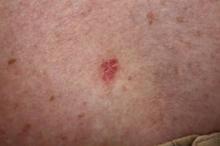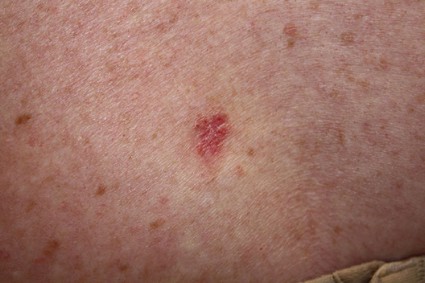User login
ALBUQUERQUE – The incidence of basal cell carcinoma in northern California rose by about 13% during 1998 through 2012, according to an analysis of more than 147,000 insured patients.
The steepest rises occurred in whites, women, and adults aged 80 years and older, while rates remained relatively stable among individuals younger than 40, said Dr. Maryam Asgari, who conducted the analysis with colleagues at Kaiser Permanente Northern California in Oakland.
Estimated rates of basal cell carcinoma (BCC) have been increasing worldwide, Dr. Asgari noted. But the epidemiology of the disease in the United States "is tricky to study, because these are not reportable cancers, and they do not have unique ICD-9 identifiers," she said at the annual meeting of the Society for Investigational Dermatology
The investigators used a previously validated BCC registry of electronic pathology reports to estimate crude and standardized 15-year BCC incidence rates by age, sex, and race with year 2000 U.S. Census data, Dr. Asgari said. The registry included 147,093 patients from Kaiser Permanente Northern California, an integrated health care delivery system. Patients were included if they developed at least one incident BCC during the study period, but were not counted multiple times for developing additional BCCs in the same year, Dr. Asgari said. The researchers used Poisson regression to examine annual changes in incidence over time.
The overall incidence of BCC increased from 418 cases per 100,000 person-years in 1998 to 535 cases per 100,000 person-years in 2012, Dr. Asgari said. "The overall standardized incidence rate for BCCs in the U.S. population for 2012 was 448 per 100,000, much higher than previously reported estimates," she and her colleagues reported.
Patients with BCCs had a median age of 66 years, and most were aged 40-80 years, with a slight male predominance (55%) that was consistent with the literature, she said. Fully 92% of affected patients were non-Hispanic whites, she noted. Kaiser Permanente patients resembled the U.S. population in terms of age and sex, but were ethnically and racially more diverse, "so the fact that we’re seeing 92% of the cohort being non-Hispanic white means BCC is really a disease of non-Hispanic whites," she said.
In contrast, the incidence of BCC decreased slightly among Asians, African-Americans, and multiracial persons during the 15-year study period, Dr. Asgari added. Among Hispanics, the incidence increased slightly in males aged 65-80 years, but decreased overall in younger persons, she said.
Based on the data, "BCCs and their treatment pose an increasing burden to the health care system," Dr. Asgari and her associates concluded.
The National Institutes of Health funded the study. Dr. Asgari reported no conflicts of interest.
ALBUQUERQUE – The incidence of basal cell carcinoma in northern California rose by about 13% during 1998 through 2012, according to an analysis of more than 147,000 insured patients.
The steepest rises occurred in whites, women, and adults aged 80 years and older, while rates remained relatively stable among individuals younger than 40, said Dr. Maryam Asgari, who conducted the analysis with colleagues at Kaiser Permanente Northern California in Oakland.
Estimated rates of basal cell carcinoma (BCC) have been increasing worldwide, Dr. Asgari noted. But the epidemiology of the disease in the United States "is tricky to study, because these are not reportable cancers, and they do not have unique ICD-9 identifiers," she said at the annual meeting of the Society for Investigational Dermatology
The investigators used a previously validated BCC registry of electronic pathology reports to estimate crude and standardized 15-year BCC incidence rates by age, sex, and race with year 2000 U.S. Census data, Dr. Asgari said. The registry included 147,093 patients from Kaiser Permanente Northern California, an integrated health care delivery system. Patients were included if they developed at least one incident BCC during the study period, but were not counted multiple times for developing additional BCCs in the same year, Dr. Asgari said. The researchers used Poisson regression to examine annual changes in incidence over time.
The overall incidence of BCC increased from 418 cases per 100,000 person-years in 1998 to 535 cases per 100,000 person-years in 2012, Dr. Asgari said. "The overall standardized incidence rate for BCCs in the U.S. population for 2012 was 448 per 100,000, much higher than previously reported estimates," she and her colleagues reported.
Patients with BCCs had a median age of 66 years, and most were aged 40-80 years, with a slight male predominance (55%) that was consistent with the literature, she said. Fully 92% of affected patients were non-Hispanic whites, she noted. Kaiser Permanente patients resembled the U.S. population in terms of age and sex, but were ethnically and racially more diverse, "so the fact that we’re seeing 92% of the cohort being non-Hispanic white means BCC is really a disease of non-Hispanic whites," she said.
In contrast, the incidence of BCC decreased slightly among Asians, African-Americans, and multiracial persons during the 15-year study period, Dr. Asgari added. Among Hispanics, the incidence increased slightly in males aged 65-80 years, but decreased overall in younger persons, she said.
Based on the data, "BCCs and their treatment pose an increasing burden to the health care system," Dr. Asgari and her associates concluded.
The National Institutes of Health funded the study. Dr. Asgari reported no conflicts of interest.
ALBUQUERQUE – The incidence of basal cell carcinoma in northern California rose by about 13% during 1998 through 2012, according to an analysis of more than 147,000 insured patients.
The steepest rises occurred in whites, women, and adults aged 80 years and older, while rates remained relatively stable among individuals younger than 40, said Dr. Maryam Asgari, who conducted the analysis with colleagues at Kaiser Permanente Northern California in Oakland.
Estimated rates of basal cell carcinoma (BCC) have been increasing worldwide, Dr. Asgari noted. But the epidemiology of the disease in the United States "is tricky to study, because these are not reportable cancers, and they do not have unique ICD-9 identifiers," she said at the annual meeting of the Society for Investigational Dermatology
The investigators used a previously validated BCC registry of electronic pathology reports to estimate crude and standardized 15-year BCC incidence rates by age, sex, and race with year 2000 U.S. Census data, Dr. Asgari said. The registry included 147,093 patients from Kaiser Permanente Northern California, an integrated health care delivery system. Patients were included if they developed at least one incident BCC during the study period, but were not counted multiple times for developing additional BCCs in the same year, Dr. Asgari said. The researchers used Poisson regression to examine annual changes in incidence over time.
The overall incidence of BCC increased from 418 cases per 100,000 person-years in 1998 to 535 cases per 100,000 person-years in 2012, Dr. Asgari said. "The overall standardized incidence rate for BCCs in the U.S. population for 2012 was 448 per 100,000, much higher than previously reported estimates," she and her colleagues reported.
Patients with BCCs had a median age of 66 years, and most were aged 40-80 years, with a slight male predominance (55%) that was consistent with the literature, she said. Fully 92% of affected patients were non-Hispanic whites, she noted. Kaiser Permanente patients resembled the U.S. population in terms of age and sex, but were ethnically and racially more diverse, "so the fact that we’re seeing 92% of the cohort being non-Hispanic white means BCC is really a disease of non-Hispanic whites," she said.
In contrast, the incidence of BCC decreased slightly among Asians, African-Americans, and multiracial persons during the 15-year study period, Dr. Asgari added. Among Hispanics, the incidence increased slightly in males aged 65-80 years, but decreased overall in younger persons, she said.
Based on the data, "BCCs and their treatment pose an increasing burden to the health care system," Dr. Asgari and her associates concluded.
The National Institutes of Health funded the study. Dr. Asgari reported no conflicts of interest.
AT THE 2014 SID ANNUAL MEETING
Major finding: The incidence of basal cell carcinoma in northern California rose by about 13% from 1998 through 2012.
Data source: Registry of electronic pathology reports of basal cell carcinomas during 1998-2012 among 147,093 patients from the Kaiser Permanente Northern California health care system.
Disclosures: The National Institutes of Health funded the study. Dr. Asgari reported no conflicts of interest.

